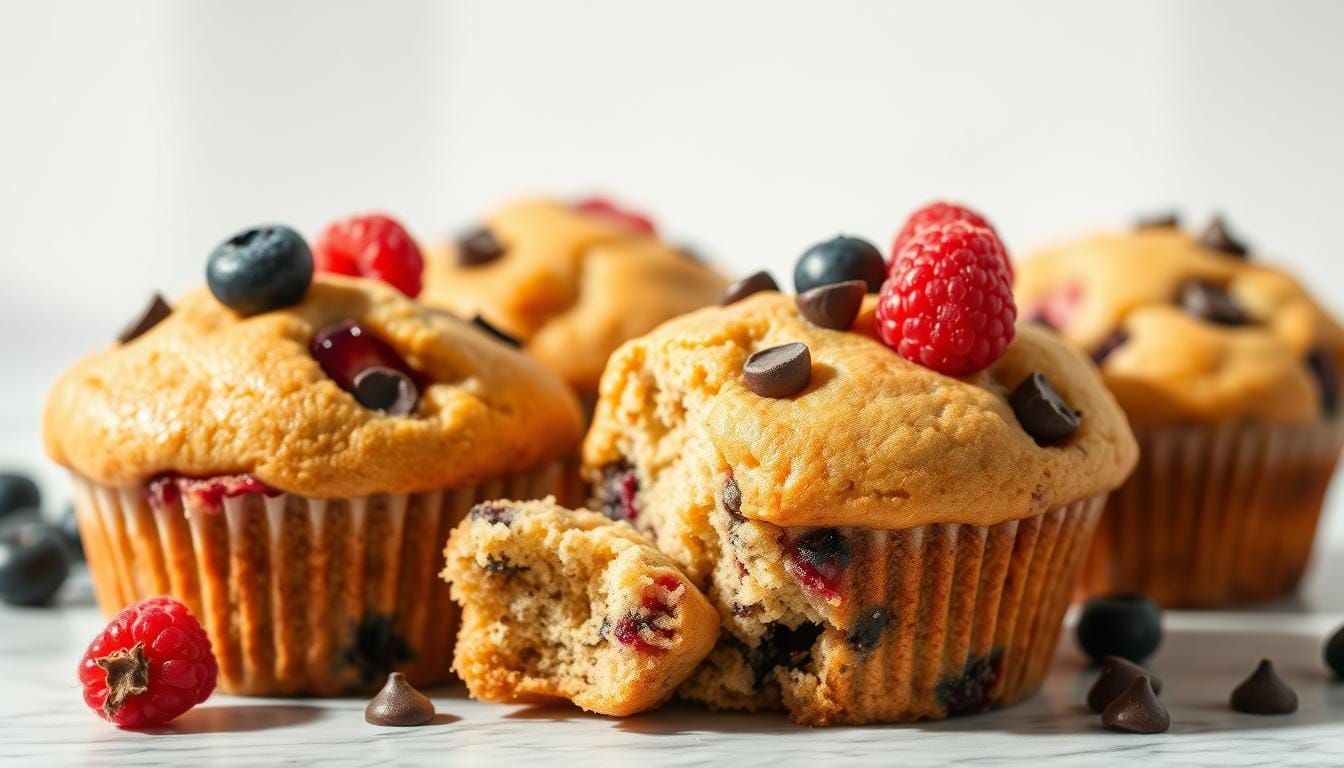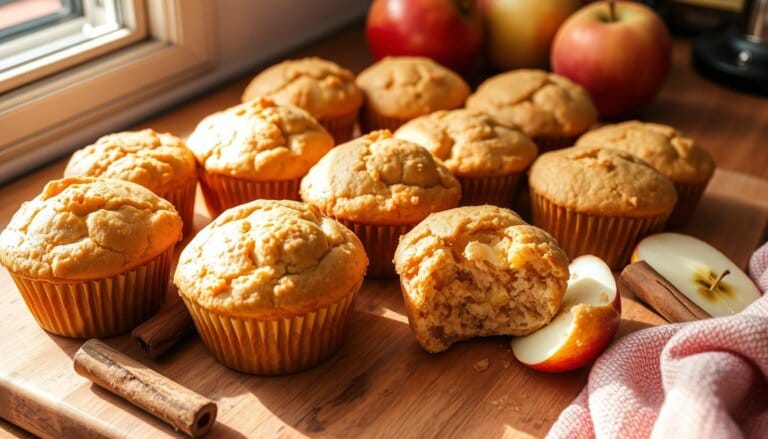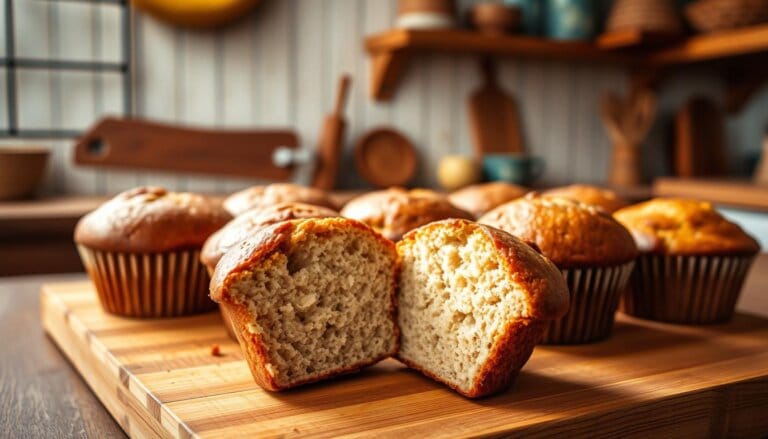Delicious Gluten Free Breakfast Muffins
Imagine waking up to the warm, inviting aroma of freshly baked gluten free breakfast muffins. For years, I struggled to find breakfast that was both tasty and safe for my diet. Those mornings of feeling left out ended when I found out how to make delicious gluten free breakfast muffins.
Gluten free breakfast muffins have changed morning meals for many with gluten sensitivities or celiac disease. They’re not just a dietary option – they’re a tasty culinary experience. Healthy eating can be both tasty and satisfying.
Whether you’re living gluten-free or just looking for healthier breakfasts, these muffins are perfect. They’re great for busy professionals and families looking for quick meals. Gluten free breakfast muffins offer a tasty and versatile solution.
Table of Contents
Key Takeaways
- Gluten free breakfast muffins are suitable for various dietary needs
- Homemade muffins offer better control over ingredients
- These muffins can be both nutritious and delicious
- Easy to prepare and perfect for meal prep
- Suitable for people with gluten sensitivities
Understanding Gluten Free Breakfast Muffins
Exploring gluten-free baking is a fun journey. It lets you create vegan muffins that taste great and are good for you. Gluten-free muffins are now a hit for those who need special diets or want a healthier start to their day.
What Makes a Muffin Gluten Free
Gluten-free muffins use different ingredients than regular muffins. Instead of wheat flour, they use flours that don’t have gluten. These include:
- Almond flour
- Rice flour
- Coconut flour
- Gluten-free all-purpose flour blends
Benefits of Gluten Free Baking
Gluten-free baking has many benefits. It lets people with gluten issues enjoy tasty treats without health risks. This makes vegan muffins recipe more accessible to everyone.
Essential Ingredients Overview
To make the perfect gluten-free muffin, you need to know the key ingredients. Xanthan gum helps with texture, just like gluten does. For a vegan recipe, focus on ingredients that add moisture, structure, and taste.
Use binders like ground flaxseed or chia seeds to get the right texture. Try different flour mixes to find the best flavor.
Best Gluten Free Flour Blends for Perfect Muffins
Choosing the right gluten free flour blend is key for tasty gluten free veggie muffins. Not all gluten free flours are the same. The right mix can greatly improve your baking.
Top recommended gluten free flour blends for your veggie muffins include:
- Bob’s Red Mill Gluten Free 1-to-1 Baking Flour
- King Arthur Measure for Measure Gluten Free Flour
- Cup4Cup Gluten Free Flour Blend
- Pamela’s Artisan Flour Blend
When picking a gluten free flour blend for your veggie muffins, think about these things:
- Texture: Find blends that give a soft, tender crumb
- Flavor: Pick blends that taste neutral, so they don’t hide the veggie flavors
- Binding properties: Make sure the blend has xanthan gum or something similar to help it stick together
If you love to tinker, making your own gluten free flour blend can be fun. A simple mix might be rice flour, potato starch, and tapioca flour in equal parts. Try different ratios to find the perfect texture for your gluten free veggie muffins.
Remember, gluten free baking takes time and effort. Each flour blend is different. So, don’t worry if your first try isn’t perfect.
Essential Equipment and Preparation Tips
Baking gluten free cheese muffins is more than just using good ingredients. You need the right tools and know how to prepare them well. Knowing what equipment and methods to use will help you make perfect muffins every time.
Must-Have Baking Tools
To make gluten free cheese muffins, you need specific kitchen tools. Here are the essential tools for your baking journey:
- Light-colored aluminum muffin tin
- Digital kitchen scale
- Silicone spatula
- Measuring cups and spoons
- Mixing bowls
- Wire cooling rack
Temperature and Timing Guidelines
When baking gluten free cheese muffins, temperature control is key. Preheat your oven to 375°F. Use an oven thermometer to check if it’s accurate. Baking usually takes 18-22 minutes, depending on your recipe.
| Oven Setting | Baking Time | Expected Result |
|---|---|---|
| 375°F | 18-22 minutes | Golden brown muffins |
| 350°F | 22-25 minutes | Softer exterior |
Measuring Techniques
Getting the measurements right is key to perfect gluten free cheese muffins. Weight measurements are more reliable than volume. Use a digital scale for dry ingredients like gluten-free flour blends and cheese. This ensures consistent results.
- Spoon dry ingredients into measuring cups
- Level off with a straight edge
- Weigh ingredients when possible
- Use clear measuring cups for liquids
By investing in quality tools and mastering precise techniques, you’ll create gluten free cheese muffins that are both delicious and professional-looking.
Key Ingredients and Substitutions
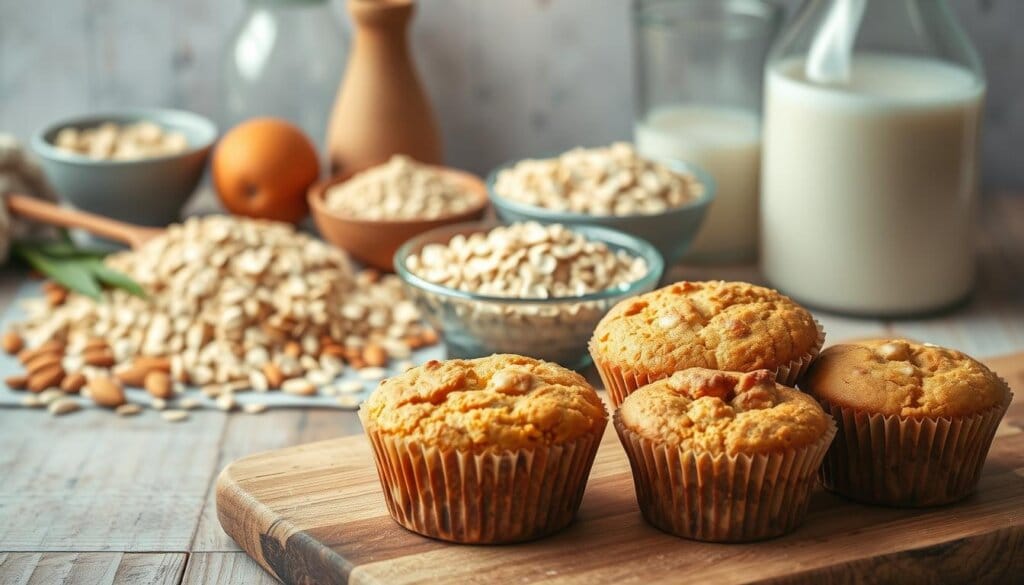
Making tasty vegan savoury muffins means knowing the right ingredients and how to swap them. It’s all about finding the right mix of flavors and textures.
Choosing the right egg substitutes is key. You can try these alternatives for structure and binding:
- Flax eggs (1 tablespoon ground flaxseed + 3 tablespoons water)
- Chia seed mixture
- Mashed banana
- Applesauce
It’s also important to find dairy-free options. Here are some milk and fat substitutes:
- Almond milk
- Oat milk
- Coconut milk
- Vegan butter alternatives
Binding agents are vital in gluten-free vegan baking. Xanthan gum and psyllium husk help with structure, like gluten does.
Try mixing different flours like almond, chickpea, or rice flour. This can lead to amazing flavors and textures. Being creative with ingredients can open up new culinary possibilities.
Step-by-Step Baking Instructions
Making gluten free savory muffins needs precision and care. The right steps can turn simple ingredients into tasty treats. Knowing how to bake is essential for perfect gluten free savory muffins.
Mixing the Wet Ingredients
Begin by mixing your wet ingredients with care. Use eggs and milk at room temperature for smooth blending. Whisk together:
- Eggs
- Milk or dairy alternative
- Olive oil or melted butter
- Herbs and spices for savory flavor
Combining Dry Ingredients
Your gluten free flour blend is key for texture. Mix a light, airy blend by sifting together:
- Gluten free all-purpose flour
- Baking powder
- Salt
- Xanthan gum (if not in flour blend)
Proper Baking Techniques
For perfect gluten free savory muffins, mix and bake with care. Fold wet and dry ingredients gently to avoid overmixing. Fill muffin cups only 2/3 full for the best rise.
| Baking Stage | Temperature | Duration |
|---|---|---|
| Preheat Oven | 375°F | 10 minutes |
| Baking Muffins | 350°F | 18-22 minutes |
| Cooling | Room Temperature | 10-15 minutes |
Check if they’re done by inserting a toothpick into the center. If it’s clean, your gluten free savory muffins are ready to enjoy!
Delicious Mix-In Options and Variations
Making gluten free breakfast muffins exciting is all about trying different mix-ins. These ingredients can turn a simple recipe into a tasty adventure. Whether you like sweet or savory, the right mix-ins can make your muffins stand out.
Sweet mix-ins can add amazing flavor to your gluten free breakfast muffins. Here are some favorites:
- Dark chocolate chips
- Chopped nuts like almonds or pecans
- Dried cranberries or blueberries
- Fresh raspberries or diced strawberries
- Shredded coconut
If you prefer savory gluten free breakfast muffins, try these:
- Crumbled feta cheese
- Diced green onions
- Crispy bacon bits
- Roasted red peppers
- Fresh herbs like rosemary or thyme
Here are some tips for adding mix-ins:
- Gently fold mix-ins into batter to prevent overmixing
- Lightly coat wet ingredients with gluten-free flour to prevent sinking
- Use room temperature ingredients for best results
Your gluten free breakfast muffins are a blank canvas for creativity. Feel free to try new combinations that match your taste.
| Mix-In Category | Flavor Profile | Recommended Quantity |
|---|---|---|
| Chocolate | Rich, Sweet | 1/2 cup per batch |
| Nuts | Crunchy, Earthy | 1/3 cup per batch |
| Fruit | Fresh, Tangy | 3/4 cup per batch |
The secret to great gluten free breakfast muffins is finding the right balance. Keep the base recipe the same, but mix in different flavors and textures.
Storage and Freshness Tips
Keeping your gluten-free vegan muffins fresh is key. Whether you’ve baked a batch or saved some for later, knowing how to store them is important. The right storage can make a big difference.
Storing your gluten-free muffins right is crucial. Vegan and gluten-free treats can dry out or lose their softness if not stored properly. So, pay close attention to how you store them.
Room Temperature Storage
Here’s how to keep your vegan muffins fresh:
- Cool muffins completely before storing
- Use an airtight container to prevent moisture loss
- Store at room temperature for up to 5 days
- Place a piece of paper towel in the container to absorb excess moisture
Freezing Methods
Freezing is a great way to keep your muffins fresh longer. Here’s a guide on how to freeze them:
| Storage Method | Duration | Recommended Technique |
|---|---|---|
| Freezer Storage | Up to 3 months | Wrap individually in plastic wrap |
| Thawing | 30-45 minutes | Room temperature or microwave |
| Reheating | 2-3 minutes | Oven at 350°F or microwave |
Pro tip: When freezing, make sure muffins are cool and wrapped well to avoid freezer burn. Also, label containers with the date to keep track of freshness.
By using these storage tips, you can enjoy your gluten-free vegan muffins for days or even weeks. They’ll stay delicious and fresh.
Troubleshooting Common Baking Issues
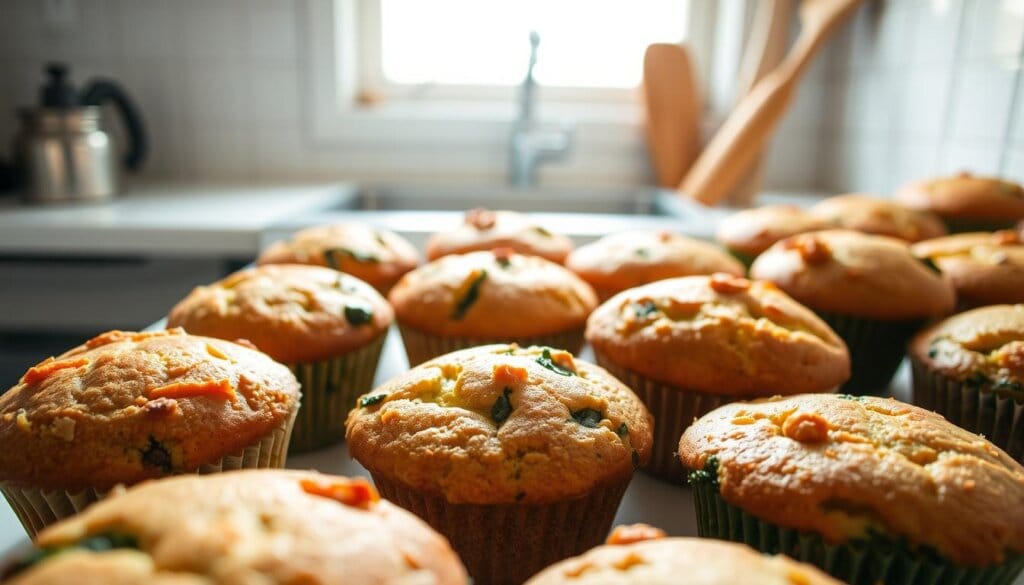
Baking gluten free veggie muffins can be tricky. Knowing how to solve common problems will help you create perfect muffins every time. Understanding the unique challenges of gluten free baking is key to achieving delicious results.
Texture issues are the most frequent challenges when making gluten free veggie muffins. Dense or gummy muffins often result from specific baking mistakes that can be easily corrected.
- Overmixing batter can develop too much gluten-free flour protein
- Incorrect liquid ratios impact moisture and texture
- Vegetable moisture content affects overall muffin consistency
Specific troubleshooting strategies can help you master gluten free veggie muffins:
| Problem | Solution |
|---|---|
| Dense Texture | Reduce mixing time, use lighter gluten-free flour blend |
| Crumbly Muffins | Add extra binding agents like xanthan gum |
| Uneven Baking | Ensure uniform vegetable size, use room temperature ingredients |
Drain excess moisture from vegetables like zucchini or carrots before adding to your gluten free veggie muffin batter. Pat vegetables dry with paper towels to prevent soggy results.
Practice and patience will help you create perfect gluten free veggie muffins that are moist, flavorful, and beautifully textured.
Making Vegan and Dairy-Free Adaptations
Creating vegan savoury muffins means finding smart swaps for taste and texture. You can turn traditional recipes into plant-based treats with a few tweaks.
Here are some key swaps for dairy and eggs:
- Egg alternatives: Ground flaxseed, chia seeds, or commercial egg replacers
- Milk substitutes: Almond milk, oat milk, or coconut milk
- Butter alternatives: Coconut oil, vegan margarine, or olive oil
When making vegan muffins, choose ingredients that add moisture and hold things together. Nutritional yeast gives a cheesy taste. Mashed veggies like pumpkin or sweet potato make the muffins moist and cohesive.
Adding protein-rich ingredients like chickpea flour, hemp seeds, or nutritional yeast boosts nutrition. These not only increase protein but also make the muffins more filling and satisfying.
Try different herbs, spices, and mix-ins to make your vegan muffins special. Roasted garlic, sun-dried tomatoes, or chopped herbs can turn a simple recipe into a gourmet delight.
Nutritional Benefits and Dietary Information
Gluten free cheese muffins are not just tasty. They can also be a healthy choice for breakfast or snacks. Knowing their nutritional facts helps you make better food choices.
The nutrition of gluten free cheese muffins changes with different ingredients. The type of flour and cheese used greatly affects their nutritional value.
Caloric Considerations
Gluten free cheese muffins usually have 180-250 calories per serving. Several things can change this number:
- Type of gluten-free flour used
- Quantity of cheese
- Additional mix-in ingredients
- Portion size
Dietary Insights
Gluten free cheese muffins are great for people with certain dietary needs. They offer many nutritional benefits:
- Protein boost from cheese ingredients
- Potential fiber enhancement with whole grain gluten-free flours
- Suitable for celiac and gluten-sensitive individuals
Whether gluten free cheese muffins are right for you depends on your nutritional needs. Talking to a nutritionist can help you enjoy these treats in a way that’s good for you.
Conclusion
Creating gluten-free savory muffins is a fun journey into new flavors. You’ve learned the basics to make your breakfast baking better. Whether you like sweet or savory, you can make treats for everyone.
Getting better at gluten-free baking takes time and effort. Each batch you make will help you get better. Try new flour mixes, add-ins, and flavors to find amazing tastes.
You’re now ready to bake with confidence and creativity. You know how to mix ingredients and use techniques to make great muffins. Start making gluten-free muffins and share them with your loved ones.
Begin baking, stay curious, and enjoy the gluten-free muffin world. Your kitchen is a place for fun and tasty adventures.

